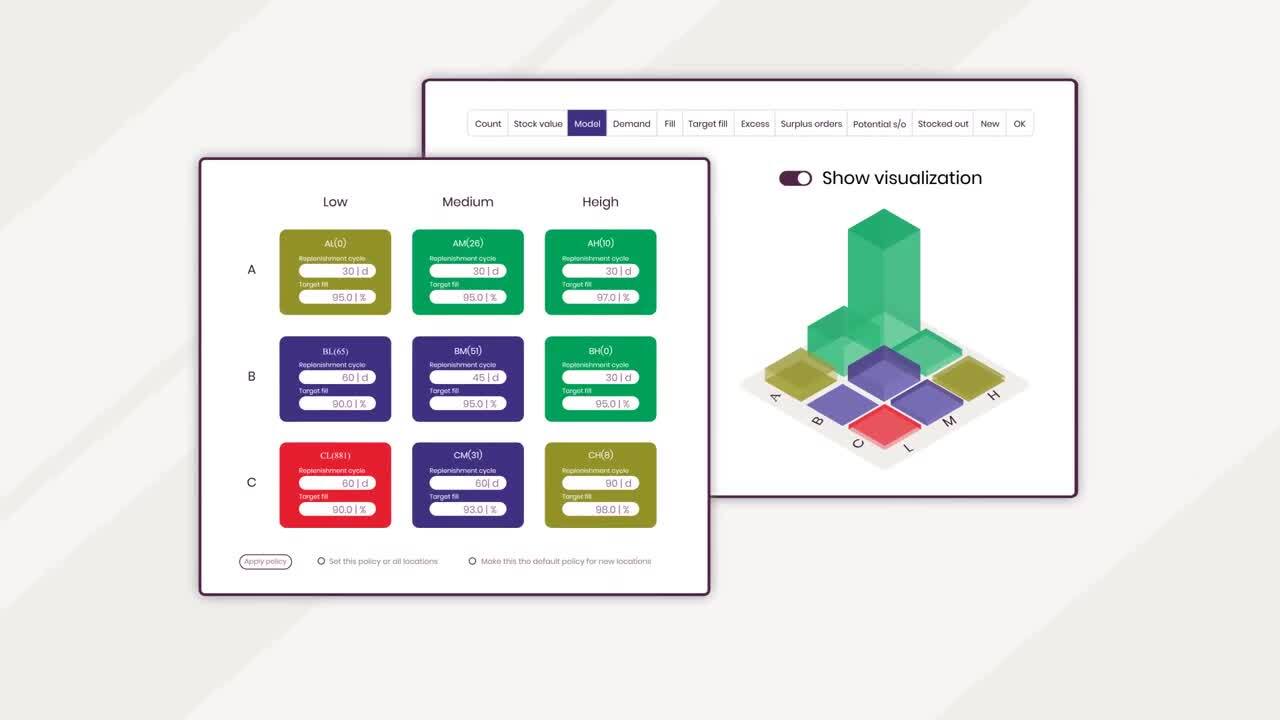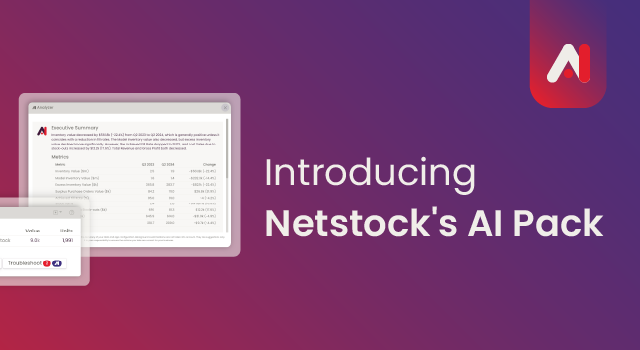Inventory is the lifeblood of your business. Strategically managing your inventory to optimize cash flow and product availability is crucial. By fully controlling your inventory levels, you can minimize waste while maximizing profitability. So, how do you achieve this perfect balance?
Let’s explore the six steps you can take to optimize your inventory.
What is inventory optimization, and what components play a part?
Inventory optimization is the strategic management of your stock levels, ensuring you have the right amount of the right product in the right place at the right time. This way, you always have enough stock on hand to meet demand while lowering your overheads and avoiding costly stock-outs or overstock situations.
The process involves analyzing data from the inventory control system to perform various tasks, including demand planning, item classification based on importance and value, setting stocking policies, assessing risks, and determining safety stock levels. The outcome of inventory optimization is a model providing recommendations on the ideal inventory levels for each item to achieve desired service levels while minimizing costs.
Your inventory can be viewed as a complex ecosystem; to thrive, a delicate balance between the various elements must be achieved. These key components work together in a continuous loop to achieve inventory optimization:
Inventory forecasting and demand planning
Wouldn’t it be great to have a crystal ball that allows you to see into the future? Inventory forecasting and demand planning do just that, offering you a glimpse of what lies ahead to help you plan better. Forecasting tools can help you accurately predict future product demand by analyzing seasonal trends and historical data. These insights can help you decide on how much inventory to hold and when you’ll need to replenish stock, minimizing the risk of stock-outs and helping you avoid the expense of storing excess inventory.
Inventory ordering
Inventory ordering puts your forecasts into action. You’ll have worked out the optimal quantity to order, and based on predicted customer demand, you can establish a replenishment schedule. You should also set a threshold that triggers new orders to ensure a smooth flow of goods and prevent disruptions caused by understocking or overstocking.
Performance analysis
An overlooked aspect of inventory optimization is keeping a close eye on your supplier’s performance. Monitoring supplier performance metrics can give you reliable lead time data to establish accurate reorder points, ensuring your stock always arrives when needed. Keeping track of your supplier’s on-time delivery record also helps you anticipate delays and adjust your ordering strategies accordingly, minimizing disruptive stock-outs. Supplier performance data also works hand in hand with demand planning, giving you highly accurate forecasts. Lastly, consistent and reliable suppliers empower you to hold lower safety stock levels, freeing up capital and storage space.
How can your business optimize inventory properly?
Optimizing your inventory means investing the right amount of capital into the right products, factoring in present and future demand, and ensuring you minimize the risk of excess stock or stock-outs. It sounds simple, but it’s tough to achieve and even tougher to maintain.
Here are six steps to inventory optimization:
- Step 1 – Item classification
- Step 2 – Safety stock
- Step 3 – Forecasts and ordering
- Step 4 – Leverage your resources
- Step 5 – Action plans
- Step 6 – Technology and tools
Step 1: Item classification
Item classification helps you prioritize and manage your stock more effectively. Each stock item in your inventory must be broken down into manageable categories:
- Obsolete
- Stocked
- Non-stocked
Once each item has been sorted into categories, the stocked items are classified even further based on specific characteristics, as this classification will dictate how they will be treated when setting inventory policies.
Why Classify?
Your warehouse is likely filled with thousands of items, each with unique demand patterns, suppliers, costs, and storage requirements. Because of this, treating all items the same way would be inefficient. Classification allows you to group similar items together, enabling you to:
- Allocate more attention and stricter controls to high-value or in-demand items.
- Implement different ordering strategies for each category, such as frequent smaller orders for fast-moving items and larger, less frequent orders for slow-moving ones.
- Organize your warehouse based on item classification to improve picking and fulfillment efficiency.
Classification Methods
- ABC Analysis: This popular method categorizes items based on their annual sales value. Typically, “A” items are high-value, “B” items are medium-value, and “C” items are low-value. This lets you focus resources on the most critical “A” items.
- VED Analysis: This method classifies items based on how critical an item is to your operations (Vital, Essential, Desirable).”Vital” items are essential for production and require the highest level of control.
- SDE Analysis: This method considers an item’s Supply lead time, Demand variability, and Economic order quantity to determine the optimal ordering strategy for each item.
At Netstock, you cannot classify inventory using sales value alone, so we introduced a second criterion that looks at sales velocity. An item may have a low value, but it may be used in many finished product assemblies or is a popular sales item, so the sales velocity will be high. This item won’t show to be important in a standard ABC (sales value), whereas it will in Netstock’s matrix.
Using item classifications allows you to focus on critical issues within your inventory that need your immediate focus.
Watch how Netstock automatically classifies your inventory
Step 2: Safety stock
Safety stock is your inventory insurance policy. It’s the extra stock you hold beyond your predicted demand to account for unforeseen circumstances and shield your business from stock-outs. Even the most perfect forecast can’t always foresee an unprecedented surge in demand (remember hand sanitizer in 2020?) or a supplier delay. Without safety stock, you’d experience a stock-out, leading to lost sales, angry customers, and disruptions to your production schedule.
Setting safety stock levels should be done at the item level instead of a blanket percentage across all inventory. The one-size-fits-all approach that so many systems apply is not good enough—not anymore. Popular, fast-moving items with unpredictable demand require a much larger buffer than slow-moving, stable ones. A blanket percentage fails to capture these nuances, potentially tying up capital in unnecessary safety stock for low-risk items while leaving critical components vulnerable.
This is why safety stock levels must be determined at the item level. This allows you to prioritize the items that matter most, optimize capital allocation, and achieve a balance between minimizing stock-outs and maximizing efficiency.
If you’re unsure how to calculate this correctly, read this article about safety stock levels, which provides more insights.
Step 3: Forecasts and ordering
The primary reason for a demand forecast for a business that holds inventory is to enable smarter replenishment decisions. Forecasts can become more challenging in a seasonal business and for businesses that keep adding new items to their inventory or when there is market volatility.
Using a forecasting tool to do the heavy lifting of demand planning will help you achieve reliable levels of forecast accuracy. You’ll still have the ability to intervene manually should you need to consider other insights, or you can use the recommendations provided by the solution.
Placing orders using the rule of thumb, i.e., ordering item A every three weeks, is not an efficient way to run your orders. Using statistical formulas that incorporate accurate sales forecasts, production or purchasing lead times, manufacturing schedules, and service-level data for each inventory item will result in more accurate orders every time. That’s why AI-enhanced forecasting capabilities can offer superior replenishment plans by using real-time data analysis. It’s automated, void of human error, and faster, improving your operational efficiency.
Here’s some useful guidelines to use when forecasting your inventory.
Step 4: Leverage your resources
Businesses often make the mistake of leaving it all up to the inventory planner or supply chain manager when it comes to tight and accurate inventory management. Although they need to make the ultimate decision, it’s important to involve other people in the organization. For example, your sales division is closer to customers and can shed more light on buying trends and potential spikes in demand. Your marketing department is on top of industry trends and upcoming promotions, which can be used to predict a potential uptick in demand in response to a marketing campaign, for example. Blend insights from different siloes to gain richer insights into your inventory planning process.
This collaborative approach allows you to make data-driven decisions and ultimately optimize your inventory strategy.
Step 5: Action plans
Even if you follow the processes listed in this article, there will be times when you either stock out or sit with excess inventory. However, proactive measures can help you to significantly mitigate these risks – in fact, we’ve produced an in-depth eBook on the five hidden causes of excess inventory to help you navigate these kinds of scenarios. For suggestions on reducing inventory stock-outs, our article titled The major causes of stock-outs provides useful tips.
Inventory leakage can also cause substantial financial strain if it goes undetected, so taking physical stock counts of your inventory keeps your finger on the pulse and is one way to ensure a clean bill of health. In the same vein, obsolete or damaged inventory can lead to wasted space, lost revenue, and tied-up capital. Here is an article that tackles this topic in more detail.
Here’s a brief overview of mitigation strategies you can use to avoid these common pitfalls:
- Establish clear reorder points and safety stock levels
- Regularly review supplier performance to proactively identify potential disruptions
- Regularly analyze sales data and identify slow-moving items, offering promotions or discounts to move excess stock
- Implement robust inventory control procedures to minimize shrinkage by using barcode scanners or warehouse management systems for improved accuracy
- Establish clear guidelines for identifying and disposing of obsolete or damaged goods by exploring options like salvage sales, returning to suppliers, or recycling programs.
Step 6: Technology and tools
A common solution that businesses choose to use is spreadsheets, and although spreadsheets are excellent for many other purposes, managing optimal inventory levels and the reordering process is not one of them. In fact, there are many limitations to managing your inventory using spreadsheets, which is why you should rather look at fit-for-purpose solutions instead. Here’s what your business needs to embrace intelligent inventory management and ditch the tedious spreadsheets for good:
- Inventory Management Software (IMS): This system tracks stock levels, automates reorder points, and generates reports to identify trends and optimize ordering strategies.
- Warehouse Management Systems (WMS): Your WMS should integrate seamlessly with your IMS, providing real-time visibility into your inventory levels. Features like barcode scanning, pick-and-pack optimization, and automated shipping processes streamline your entire fulfillment process.
- Demand Forecasting Software: These AI-powered tools are integrated into your IMS and can analyze vast amounts of data to predict future demand with superior accuracy. This empowers you to order the right amount of stock at the right time, minimizing the risk of stock-outs and excess inventory.
Step up your inventory optimization
Inventory management done right can help you streamline your operations, free up capital, and always be ready to take advantage of growth opportunities. With so many variables to consider nowadays, manual processes simply cannot handle the complexities of modern inventory management. Your business needs a robust and intelligent solution that goes beyond basic functionality.





